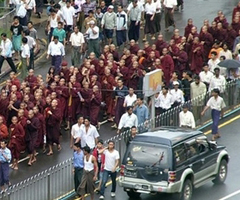
|
|
|
Home Asia Pacific South East Asia Myanmar Myanmar Protest News Burma: not yet a saffron revolutionBy Renaud Egreteau, Le Monde Diplomatique, Nov 4, 2007
International observers and world media paid devout attention to the recent demonstrations and protests in Burma, led by courageous young Buddhist monks. Though they haven’t shifted the regime, they are still marching.
A rise in October 2005 provoked nothing comparable to the events this September, which created havoc in Rangoon and Burma’s larger towns. In the early stages, it was not clear that street demonstrations by a few militants would start a major social upheaval; that was before the marches of the sangha, Burma’s community of Buddhist monks. The rise in fuel prices has had a direct impact on people’s lives, especially in towns. The cost of public transport has almost doubled, and many urban pavement generators used to make up shortfalls in the electricity supply have fallen silent. Consumer prices have soared. The handful of democratic militants still at large lost no time in denouncing the damaging effects of this latest arbitrary decision by the military authorities; most of them belong to Generation 88, the informal group of former students active during the summer uprising of 1988, which was quashed by the junta with 3,000 deaths.
Just as the fragile protests seemed to be running out of steam (as have most such events over the past 20 years), signs of dissent started to emerge from within the sangha. This is a pillar of Burmese society. The monks are venerated by the people, most of whom have spent months or even years as members of the order. As a result of the price rises people have found it difficult to offer alms of food and other essentials to the sangha. Seeing the disarray this caused, and with more of the population struggling to fulfil their obligations, several hundred novices took to the streets in spontaneous and peaceful marches. Most of the young monks came from the monasteries in Rangoon or central Burma whose elder hierarchy were prepared to accept them taking to the streets. Their aim was to denounce the high cost of living and appeal for a reduction in prices. Separate initiatives As all monasteries in Burma are autonomous, these protests have to be seen as the result of separate initiatives by communities rather than a concerted campaign by the sangha. They were propelled by young novices suffering, like their families, from straightened economic conditions. When the regime intervened the events took on a new dimension. Although the arrival of the monks had added weight to the movement, it still suffered from a lack of charismatic leadership, and the junta, in a familiar routine, set about destabilising the protesters by sending in its agents from the Union Solidarity and Development Association (USDA). This is a huge civil organisation, founded in 1993 under the patronage of General Than Shwe, head of the junta. It has 15-18 million members out of a population of 47 million. Since early this year observers have been concerned by rumours of the creation of the Pyithu Swan Arr Shin, a special force within the USDA, secretly trained by the army in street fighting and the disruption of demonstrations. The Swan Arr Shin seems to have acquired a terrifying reputation over the past few months. Its 1,000-strong members are ex-convicts pardoned by the regime, and Muslim or Christian supporters of the junta. On 5 September Swan Arr Shin agents violently disrupted a march by a few hundred monks in the streets of Pakokku, a small town to the southwest of Mandalay, injuring many of the marchers. Anger swelled among younger monks, and next day they surrounded the largest monastery and detained a number of local officials who came to apologise for the incident. The news travelled fast across the country and new demonstrations erupted in protest at the regime’s inaction. A month after the rise in prices the authorities had still not taken measures to improve the economic situation. And seeing the apparent lack of leadership and coordination among the protesters the regime let the protests grow; it has always been careful to appease the leading elders of the sangha and could not now afford to act as repressively as in 1988. The result was unlike anything that has been seen over the last 20 years, with demonstrations in the larger towns reported in the international media, thanks to the photographs smuggled out and reports by underground activists. Engaged but divided Nonetheless it seems that there were only 15,000 to 20,000 monks among the 100,000 demonstrators said to have taken to the streets of Rangoon on 24 and 25 September: most were local bystanders, attracted by the spectacle and unaccustomed to such defiance of the law. Many Burmese from old apartments in the Anglo-Indian quarter were caught up in the euphoria and came down on to the streets to watch the monks filing courageously past; they handed out drinks and applauded, but were not part of the rally itself. At the request of the monks, and for fear of reprisals, there were few militant banners, portraits of Aung San Suu Kyi, or flags of the fighting peacock (the symbol of the NLD) seen on the march. It was much the same in Mandalay, Sittwe or Toungoo, with no real coordination or political engagement by the population as a whole. Nor did all the monasteries in Rangoon or elsewhere try to join the demonstrations. This highlights the divisions within the Buddhist community: many of the elders were unhappy with the activism of the younger monks, frowning on the public manifestation of worldly concerns. Even so, there is a long tradition of political engagement by the Buddhist community and Buddhism was one of the driving forces of Burmese nationalism early in the 20th century. The Buddhist monks U Ottama and U Wisara became well known for their pacifist opposition to British colonialism; in 1929 U Wisara’s commitment to non-violence resulted in his death in a colonial jail after 160 days on hunger strike. General Ne Win, the leader of the military regime that isolated Burma from the rest of the world between 1962 and 1988, was determined to stifle the clergy’s opposition by passing authoritarian decrees guaranteeing administrative control over the sangha. The new junta continued after 1988, with a decree in 1990 that limited the monks’ freedom of speech and association, and placed them under the authority of the junta’s ministry for religious affairs. Many monasteries have continued to nurture silent opposition; Thamanya in the state of Karen is well known for its sympathies with Aung San Suu Kyi and her pro-democratic campaign. But most remain traumatised by the violent repression of the 1988 uprising and are probably not ready to launch a street revolution, despite the disarray affecting the sangha. This can be explained by the lack of any centralised hierarchy, and the Sangha’s infiltration by the secret services. This makes it difficult to establish any unified stance against the regime, despite occasional campaigns such as the alms boycott when monks turned down their bowls, refusing alms from the military and their families (as they did in 1990 in Mandalay). The junta will always find monasteries prepared to support it; for years it has been generous in funding them, embellishing pagodas and giving the elders privileges, especially the Maha Sangha Nayaka, the state’s committee of high-ranking Buddhist clergy. An urban uprising Besides the divisions within the sangha, there is also little unity within the population. The events of September were limited to the Bamar people, who live in the centre of the country and make up two-thirds of the population. Minority groups, mainly Christian or Muslim, live in the less accessible mountain regions forming a horseshoe around the ancient Bamar homeland, and they were far less involved. Although there were demonstrations in some rural towns like Taunggok or Pakokku, this has been an urban uprising and the protests have not crossed the country as in 1988. More importantly, the regime is better positioned today than 20 years ago, when General Ne Win resigned leaving a vacuum to be filled. When the regime relocated the capital from Rangoon to Naypyidaw, over 300km to the north, in November 2005, it achieved much tighter control over its governmental system, for it removed the military headquarters and the staff of the civil service and ministries from rebellious Rangoon. Many of the staff had joined the protesters in 1988 and participated in the general strike. For the time being the tactics seem to be paying off: the centre of power has not been unsettled by the demonstrations. The junta was also skilful in deploying its most loyal and experienced troops (the 22nd and 77th light infantry divisions) to stifle the movement, in Rangoon especially. It also made good use of its civilian militia in an operation of less visible repression. There have been few cases of desertion reported among the ranks, providing little support for claims of collapse within the military, even though they were embarrassed at having to deal with an insurrection of monks – Burma’s regimes, royal, democratic or military, have always relied on religion to legitimise their political authority. The September protests came as a surprise because of the lethargy of Burma over the past decade. But they cannot be compared with the events that have shaken Ukraine, Georgia or Lebanon – this is no saffron revolution despite the international media’s hasty conclusions. There are too many obstacles preventing any real revolutionary progress: the differences within the sangha and the geographical limits of the Bamar insurrection, the brutal but efficient deployment of military and paramilitary force, and an international community reduced to symbolic declarations because of its lack of influence within the country and over a regime entrenched in its xenophobic and isolationist credo. The Burmese are well aware of this. Political change will require concessions by all the parties involved – the junta, the opposition forces, the ethnic minorities, the international community – and it will take more than a street rebellion, even by monks. |
 Get your Korean Buddhist News here, brought to you by BTN-Buddhist Channel |
 |
 The Mandala app brings together Buddhist wisdom and meditation techniques with the latest insights of psychology and neuroscience to handle the challenges and complexities of modern life. The App offers a series of engaging talks and conversations with experts on a wide variety of topics, such as managing stress, dealing with adversity, developing greater resilience, cultivating empathy and compassion, creating healthy relationships, and many more. These topics are explored to help find greater peace, meaning and joy in our lives. Our panel of experts include Dr, Thupten Jinpa, Daniel Goleman, Kelly McGonigal and others.FREE DOWNLOAD here |
| Point
your feed reader to this location |
| Submit an Article |
| Write to the Editor |

 Paris, France -- When the military regime in Burma decided to raise oil and gas prices in August it sparked off a social and economic crisis of unexpected proportions.
Paris, France -- When the military regime in Burma decided to raise oil and gas prices in August it sparked off a social and economic crisis of unexpected proportions. 